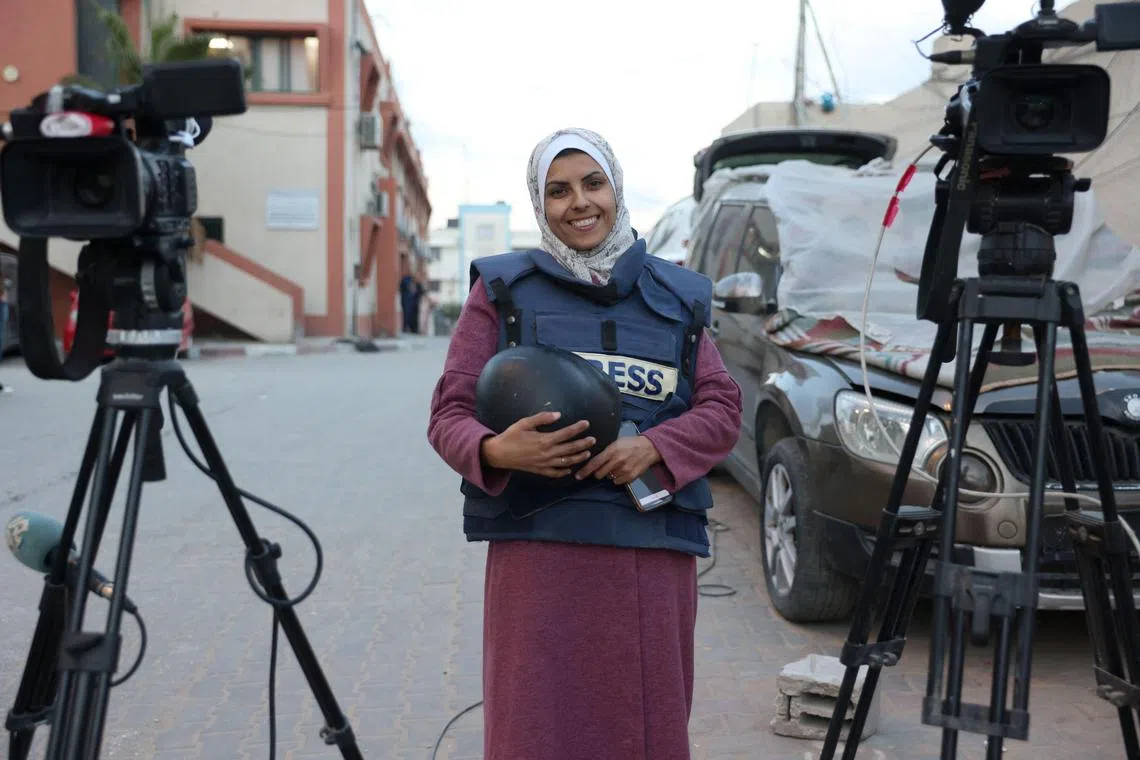Who are the journalists killed in Israel’s strike on Nasser Hospital in Gaza?
Sign up now: Get ST's newsletters delivered to your inbox

Ms Mariam Dagga was a 33-year-old visual journalist who was a freelancer for The Associated Press. She was one of five journalists killed in an Israeli strike on Nasser Hospital in Gaza.
PHOTO: AFP
Matthew Mpoke Bigg
Follow topic:
JERUSALEM - Five Palestinian journalists who worked for international news organisations were killed in the Gaza Strip on Aug 25, along with several others, in what local officials said was an Israeli strike on Nasser Hospital
Several more people were also killed in the strike, according to Gaza Health Ministry officials.
Israel said it had carried out a strike in the area of the hospital, but did not identify the target. The Israeli military said in its statement that it “does not target journalists as such”. At least 192 journalists have been killed since the start of the war, according to the Committee to Protect Journalists.
Israel’s Prime Minister Benjamin Netanyahu said the deaths were a “tragic mishap”.
“Israel values the work of journalists, medical staff and all civilians,” Mr Netanyahu said in a statement. “The military authorities are conducting a thorough investigation.”
These are the journalists who were killed on Aug 25:
Mariam Dagga
A 33-year-old visual journalist, Ms Dagga was a freelancer for The Associated Press and other news outlets.
Ms Dagga’s son had been evacuated from Gaza earlier in the war, the news agency said in a story.
Mr Jon Gambrell, a regional news director for the AP, said on social media that Ms Dagga had freelanced for the organisation since the start of the war in October 2023.
The news organisation said in a statement that Ms Dagga had regularly based herself at the hospital. It said that in August, she had reported on starving and malnourished children in Gaza.
Independent Arabia, the Arabic-language version of the Independent newspaper in Britain, said in a post on social media that Ms Dagga had been a photographer for the organisation, and posted photographs of her wearing a flak jacket with the word “Press” on it.
The AP said that it was “shocked and saddened” by her death.
“We are doing everything we can to keep our journalists in Gaza safe as they continue to provide crucial eyewitness reporting in difficult and dangerous conditions,” it said.
Hussam al-Masri
Reuters announced the death of Mr al-Masri, a cameraman, in a statement and said that another one of its contractors, Mr Hatem Khaled, had also been wounded in Israeli strikes on the hospital.
A Reuters story said that Mr Khaled was a photographer.
“We are urgently seeking more information and have asked the authorities in Gaza and Israel to help us get urgent medical assistance for Hatem,” Reuters said.
It did not immediately respond to a request for biographical information about the two men.
Mohammad Salama
Al Jazeera said that Mr Salama, a cameraman, was the 10th journalist for the network to have been killed since the start of the war.
In a statement, Al Jazeera, which is based in Qatar, condemned the killing and said that Israeli forces had “targeted and assassinated journalists as part of a systematic campaign”.
Middle East Eye, a London-based online news outlet, said on social media that Mr Salama had worked for it since the start of the conflict.
In August, Mr Anas al-Sharif, an Al Jazeera journalist and one of the most prominent correspondents working in Gaza, was killed along with three other journalists for the network in an Israeli strike on the tent where they worked in Gaza City. In all, five journalists died in that attack.
Israel said it had targeted Mr al-Sharif and accused him of being a Hamas operative posing as a reporter. Al Jazeera refuted the accusation and said he was one of Gaza’s bravest journalists.

(From left) Hussam al-Masri, Mariam Dagga, Moaz Abu Taha, Mohammad Salama and Ahmed Abu Aziz.
PHOTOS: REUTERS
Ahmed Abu Aziz
Mr Abu Aziz, a freelance journalist in Khan Younis, had contributed to dozens of reports for Middle East Eye since the start of the conflict, according to a story by the outlet, which said he worked despite a serious back injury that had gone untreated.
Both Mr Abu Aziz and Mr Salama were “exceptional journalists” who worked in “near-impossible conditions”, said Middle East Eye’s editor-in-chief, Mr David Hearst, according to a story by the outlet. Mr Hearst did not immediately respond to an e-mail requesting further comment.
Mr Abu Aziz praised the Hamas-led Oct 7, 2023 attacks on Israel in social media posts shortly after the event. Human rights groups and groups that support journalists say that such posts do not, in themselves, provide legitimate grounds for a military strike on a person. Middle East Eye did not immediately reply to an e-mail requesting comment on the issue.
Moaz Abu Taha
Reuters said in a statement that Mr Abu Taha was a freelance journalist whose work had been occasionally published by the agency.
Further details on Mr Abu Taha were not immediately available.
NYTIMES

